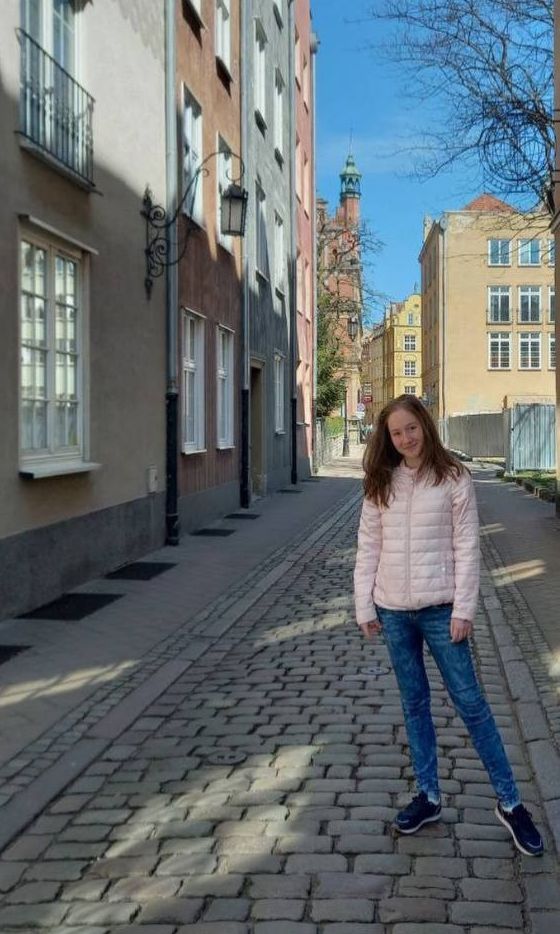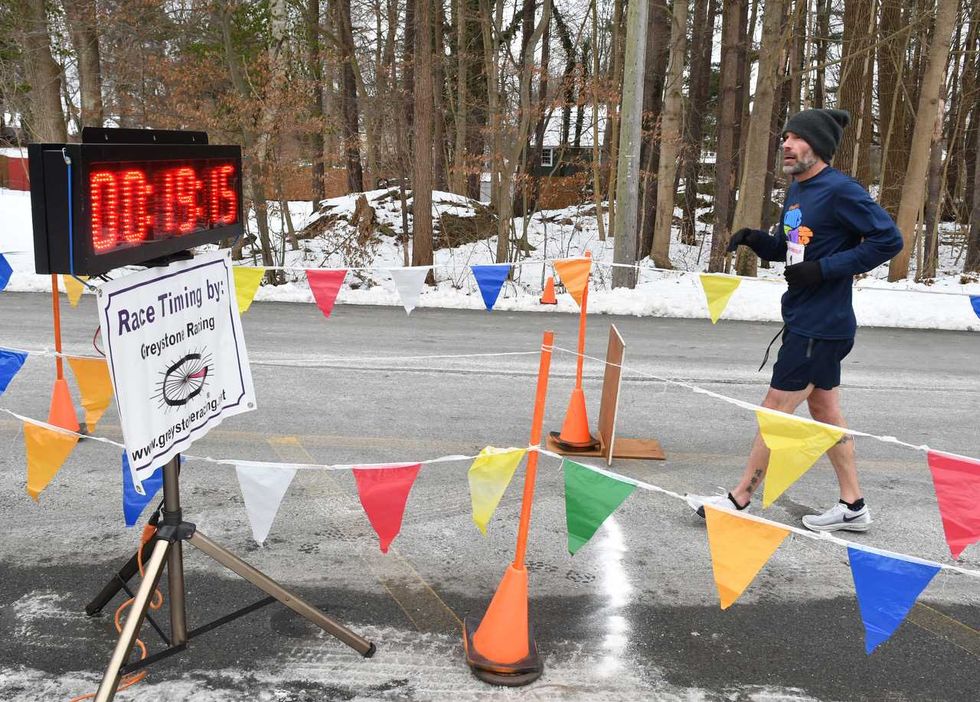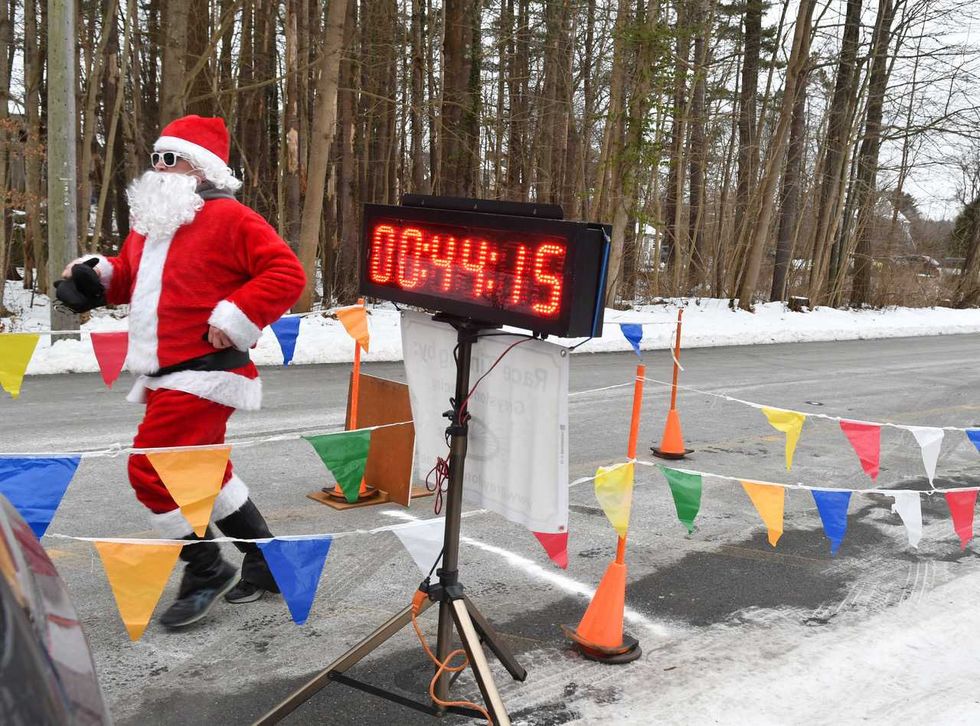From Kyiv to Connecticut

Ira Buch in Gdansk, Poland, after the war broke out in Ukraine in 2022.
Provided

Ira Buch in Gdansk, Poland, after the war broke out in Ukraine in 2022.
January, 2022. My new year celebration in Ukraine was accompanied by cheerful optimism for the upcoming year. After being wrongly diagnosed with lupus, this time marked the end of 12 months of everlasting hospital visits, biopsies, and analysis. Looking ahead, I hoped to spend the coming year with my family and friends, as the need for my isolation had passed.
But then, on Feb. 24, 2022, the world turned upside down. With explosions outside my home in Kyiv, all I could wish for was the isolation and silent safety I once knew in those hospital rooms.
My family fled Kyiv to one of the small neighboring towns – Borodyanka. The town was surrounded by the occupiers the following day. We soon learned that the explosions signified safety: they meant that there was still a fight to be had.
Under the shells of Borodyanka, I continued working on my application to Ukraine Global Scholars (UGS), a program designed to help Ukrainian youth through their application process to top boarding schools and colleges in the U.S. Within a few days, the Russian military hit the only grocery store, power plants, and internet tower in the area. Running low on food and water, our only source of information became the radio, which translated stories of the terrors from the neighboring regions.
Two weeks later we were evacuated from the city. The neighboring family knew of the situations in the nearby towns, which were temporarily controlled by the Ukrainian army. With them, we placed white sheets on the car and drove through forests and a few villages to get to the Polish border. I submitted my UGS application in a big multi-family room of a refugee center in Warsaw, Poland.
My UGS acceptance notification was followed by a six-month application process to U.S. boarding schools.
On March 10, 2023, the results came out: acceptance from Hotchkiss. I was overwhelmed with joy. Neither my parents nor I had ever traveled abroad before the full-scale war broke out. Following my acceptance, my mom and I returned back home to Kyiv. With the visa application, preparations, and occasional explosions, the summer went by quickly.
The next thing I knew, I was on my way to the United States (my first time traveling alone). A bus, two trains, two flights, and one car drive later, I arrived in Lakeville. As I came to Hotchkiss for the fall semester, I was struck by the drastic differences in the educational system. Six chosen classes substituted eighteen fixed classes I took in Ukraine. The focus shifted from memorizing material to learning how to discuss, interpret, and analyze data. The analysis and interpretation of the readings and assignments became the priority. On the other hand, after-school activities became as important, if not more important, than academics. From community service to athletics and research projects, I was spinning in choices.
For the first two months, I struggled to adapt to the new expectations in and outside of the classroom. It was difficult to construct effective essays according to the new methods, and grasping math topics from a new perspective became a challenge. At my Ukrainian school, we covered parts of precalculus and calculus, never fully finishing either of them. At Hotchkiss, I was placed into a calculus class where the themes were based on concepts I had never fully studied. I struggled to keep up with my classmates, every one of whom seemed to have complete control over their activities and goals. At that time, I was lucky to have been met with support and feedback from my teachers, improving my understanding of the expectations and requirements. With their support, the B on my essay transformed into an A, and math concepts became easier to grasp. The confusion with the U.S. measurement system, however, persisted. I still interpret Fahrenheit and miles connotations based on the context.
During the winter break, I had an opportunity to travel to Germany with some of my classmates. The trip was one of the best experiences of the year: we practiced German, drove the U-Bahn, and visited Christmas markets, museums, and shows.
After the trip, I was able to go home and spend the New Year with my family. The trip back was accompanied by the Russian New Year’s Eve bombing and, as a result, a missed bus in Poland. One bus turned into three to get to Berlin’s airport. Back home, the snowy landscape was reminiscent of the Lakeville weather. The howl of the wind, however, was replaced by the howl of Russian shaheds, drones and missiles, explosions instead of the celebratory fireworks, and commemoration of those killed by the Russian invasion instead of the celebration of the past year.
February, 2024. Two years after the beginning of the full-scale war and ten years after the initial Russian invasion. With the enormous support of the school and the local community, Oleh, my friend from UGS, and a Hotchkiss classmate, and I launched a fundraising campaign and a photo exhibition at the school. The exhibition featured photos taken by my family and friends, as well as other families. Here, Oleh and I got an opportunity to share our stories. I was struck by the outpouring of support we received and the community’s awareness of the situation in my home country.
As time marched on, Lakeville slowly transitioned into the spring season. Since coming to Hotchkiss, spring has become my favorite part of the year. The classrooms and hallways are no longer stressful, but familiar. I started feeling at home on campus and during class discussions and assignments.
In the blink of an eye, Lakeville’s transition between winter and spring was complete with flowers, sun rays on the windows, and a pleasant rise in temperature. A two-year whirlwind culminates with peace.
Ira Buch is a junior at The Hotchkiss School. She will be returning to Ukraine this summer before coming back to Hotchkiss for senior year.
Housatonic Valley Regional High School, where the price of school lunch will increase to $4.00 beginning Jan. 5.
FALLS VILLAGE -- School lunch prices will increase at select schools in Regional School District No. 1 beginning Jan. 5, 2026, following a deficit in the district’s food service account and rising food costs tied to federal meal compliance requirements.
District officials announced the changes in a letter to families dated Monday, Dec. 15, signed by Superintendent Melony Brady-Shanley and Business Manager Samuel J. Herrick
Under the new pricing, lunches at Lee H. Kellogg School and Cornwall Consolidated School will increase by 25 cents to $3.75, while lunches at Housatonic Valley Regional High School will rise by 50 cents to $4.00.
According to the district, the food service program depends on revenue from lunch sales as well as federal reimbursement. Increased food costs and compliance requirements contributed to the shortfall during the 2024–2025 fiscal year.
School lunch prices have remained unchanged since the 2019–2020 school year, prior to the COVID-19 pandemic. In the years that followed, the district used COVID-19 relief funds to allow students to receive lunches at no cost.
Families who believe they may qualify for free or reduced-price lunch may apply at any time during the school year. Applications are available online for Housatonic Valley Regional High School, Lee H. Kellogg School and Cornwall Consolidated School.
The lunch price increase applies only to these three District No. 1 schools, as Housatonic Valley Regional High School oversees the food service programs at Lee H. Kellogg School and Cornwall Consolidated School. Other schools in the district operate independent food service programs and are not affected.
Runners line up at the starting line alongside Santa before the start of the 5th Annual North Canaan Santa Chase 5K on Saturday, Dec. 13.
NORTH CANAAN — Forty-eight runners braved frigid temperatures to participate in the 5th Annual North Canaan Santa Chase 5K Road Race on Saturday, Dec. 13.
Michael Mills, 45, of Goshen, led the pack with a time of 19 minutes, 15-seconds, averaging a 6:12-per-mile pace. Mills won the race for the third time and said he stays in shape by running with his daughter, a freshman at Lakeview High School in Litchfield.

Don Green, 64, of Red Hook, New York, was second among male runners with a time of 21:17 and a 6:52-per-mile pace. Becky Wilkinson, 47, of Southfield, Massachusetts, was the first woman to cross the finish line with a time of 22:16, averaging a 7:11-per-mile pace. Wilkinson finished fourth overall.
Margaret Banker, 52, of Lakeville, finished second among women runners with a time of 23:59 and a 7:44-per-mile pace.
Runners came from all over Connecticut, Massachusetts and New York. One runner listed home as London, England. Many were members of the Run 169 Towns Society, a group that is dedicated to completing races in every one of Connecticut’s 169 towns. Elizabeth Smith, 32, of Manchester, a member of Run 169, said this was her 162nd town.
“I started 10 years ago,” Smith said. Her husband, Daniel, 33, has run races in 73 Connecticut towns, now including North Canaan. He was eager to know where to get a good cup of coffee after the race.
Santa, who got a head start on the group of runners but finished next to last with a time of 44:14, has been a feature in the North Canaan race since it started five years ago.
The 5K proceeds from a start in front of the North Canaan Elementary School on Pease Street to course around the Town Hall parking lot, up West Main Street past the transfer station to the state line and back. Cheryl Ambrosi, 45, of Danbury, was the last to cross the finish line with her dog Benji. “It was so much fun,” she said as she ended, even though she didn’t catch Santa.

The Torrington Transfer Station, where the Northwest Resource Recovery Authority plans to expand operations using a $350,000 state grant.
TORRINGTON — The Northwest Resource Recovery Authority, a public entity formed this year to preserve municipal control over trash and recycling services in northwest Connecticut, has been awarded $350,000 in grant funds to develop and expand its operations.
The funding comes from the Department of Energy and Environmental Protection via its Sustainable Materials Management grant program. It is intended to help the NRRA establish operations at the Torrington Transfer Station as well as support regional education, transportation, hauler registration and partnerships with other authorities.
Founded by the City of Torrington in May 2025, the NRRA was established to oversee regional municipal solid waste management. Its creation followed a $3.25 million offer by USA Waste & Recycling to purchase the Torrington Transfer Station — a sale that would have privatized trash services in the region.
The proposed sale was initially approved by the MIRA Dissolution Authority, the entity responsible for dissolving the state’s former Materials Innovation and Recycling Authority, which owned the Transfer Station at the time. Before the transaction could close, the state intervened and directed that the facility’s operating permit be assigned to the NRRA to preserve a publicly controlled alternative.
MIRA has since dissolved, and the Transfer Station is currently operated by the state Department of Administrative Services. Many towns in northwest Connecticut have expressed interest in joining the NRRA. As of December, Torrington and Goshen were the only two municipalities in the authority.
At the Dec. 11 meeting of the Northwest Hills Council of Governments (COG) — a regional planning body representing 21 municipalities in northwest Connecticut — Director of Community and Economic Development Rista Malanca encouraged more towns to sign on.
“We need towns to join the Northwest Resource Recovery Authority to show your support, show this is what you want to do,” Malanca said.
Salisbury First Selectman Curtis Rand said his municipality is planning a town meeting in January to vote on a resolution to join the NRRA. Cornwall’s Board of Selectmen recently discussed scheduling a town meeting in the winter for the same purpose. Sharon, Falls Village and North Canaan have also expressed continued interest in pursuing a public option.
Kent is the northernmost member of the Housatonic Resource Recovery Authority, a regional solid waste authority representing 14 municipalities stretching south to Ridgefield. COG towns expressed interest in joining HRRA in 2024, but they were denied and set out to develop the NRRA.
“We also have been having conversations with the Capital Region Council of Governments and the Naugatuck Valley Council of Governments to think about how we can use existing resources, maybe some of these grant funds, to bring in shared resources or shared staffing that will help with some of the recycling coordinating efforts,” Malanca said.
With grant funds secured, NRRA aims to grow to a point that it can take over operations at Torrington Transfer Station to serve as a regional hauling hub. What happens to the trash after that has yet to be determined. Currently, it is being shipped to a landfill out of state. The existing municipal refuse hauling contracts that were established with the state expire in 2027.
The Salisbury Winter Sports Association (SWSA) will host its annual Junior Jump Camp, a two-day introduction to ski jumping, on Saturday and Sunday, Dec. 27 and 28, from 9 a.m. to 2 p.m. at Satre Hill in Salisbury.
The camp is open to children ages 7 and up and focuses on teaching the basics of ski jumping, with an emphasis on safety, balance and control, using SWSA’s smallest hill. No prior experience is required.
The cost is $50 per child and includes instruction and lunch on both days. For more information or to register, visit www.skireg.com/swsa-camp or email info@jumpfest.org